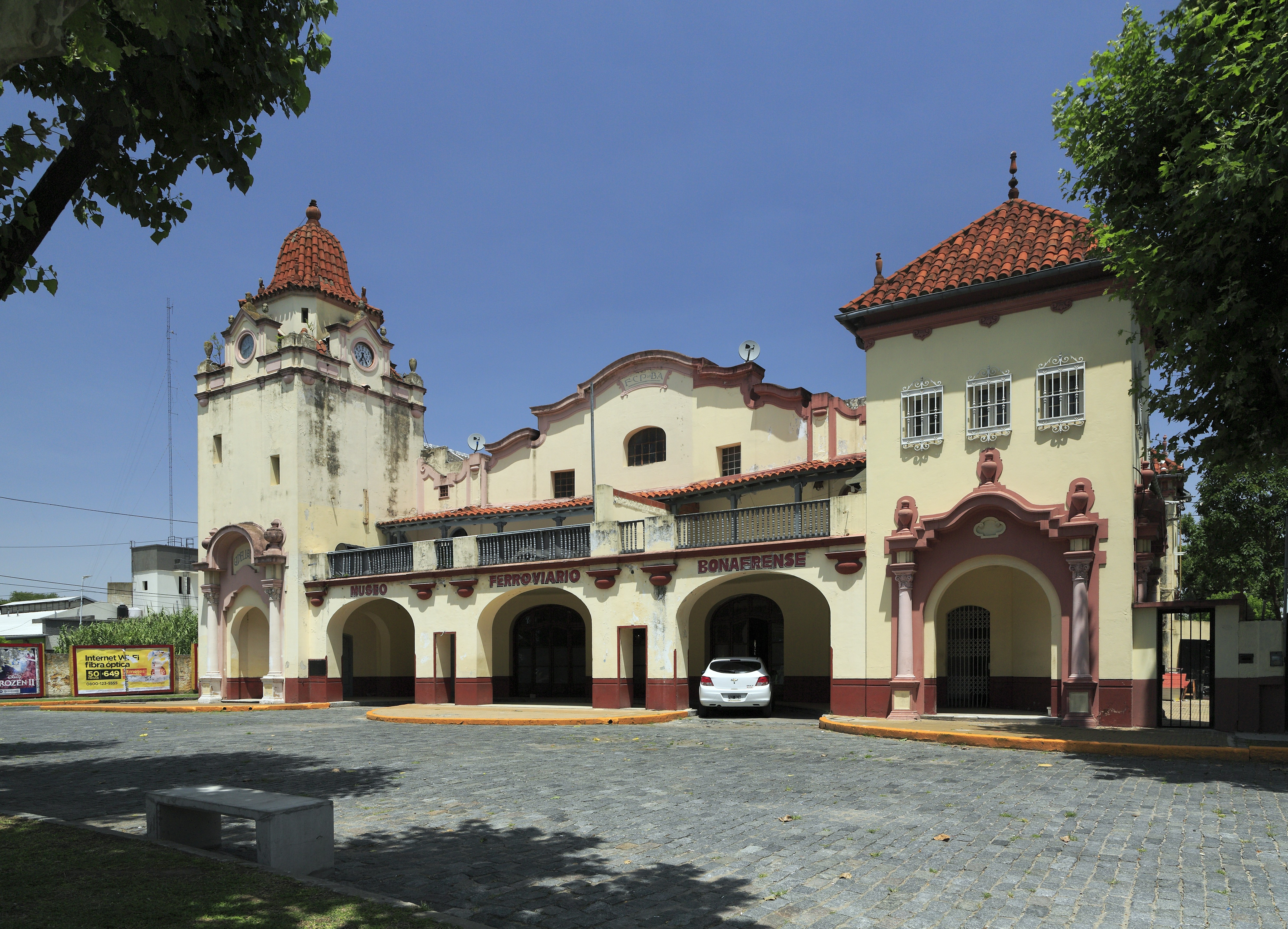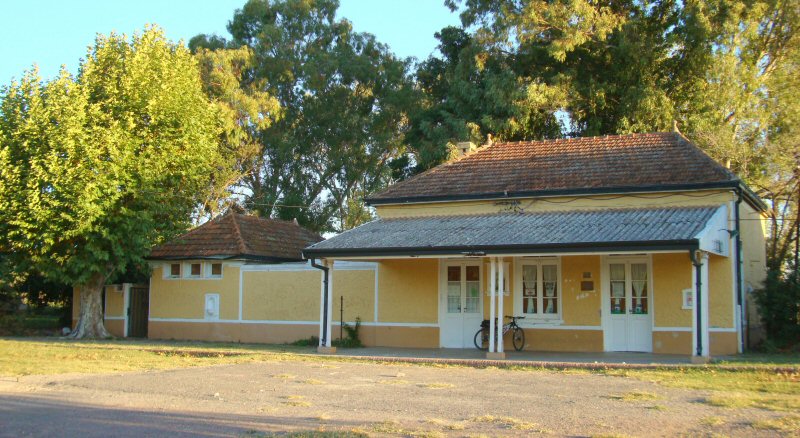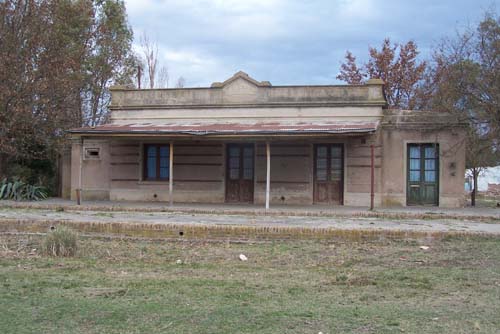Province of Buenos Aires Railway on:
[Wikipedia]
[Google]
[Amazon]
The Province of Buenos Aires Railway ( es, Ferrocarril Provincial de Buenos Aires - FCPBA) was a state-owned company that operated a 902 km railway network in the Province of







on Portal de Trenes by Franklin Romero, 22 Jan 2019 The line was officially opened on 7 January 1914, but was not opened to public until 17 May. In March 1912, under the Inocencio Arias administration, the "Sociedad Ferrocarril Puerto de La Plata al Meridiano V" was created but its first trade balance was negative due to the line was still incomplete. Moreover, as harvest season had finished, other rail companies had been commissioned to transport the harvest. In December 1913, the Ferrocarril La Plata (a
by Oscar Rodríguez on Portal de Trenes, 4 Aug 2018 In 1936, the Provincial Government introduced a draft law with several proposes for the FCPBA, including three main options: 1) selling to the National government-, 2) agreements with other rail companies that served the same regions; 3) an improvement plan that included creation of urban centers in some stations, and settlement of adjacent areas, among others. The idea of selling the line was based on the excessively low prices, the proximity of other lines (from rival companies) serving the same regions, and the low profits during the 1926–35 period (with few exceptions). Finally, the third option was chosen.El Ferrocarril Provincial (Segunda Parte)
on Portal de Trenes by Franklin Romero, 29 Jan 2019 In the mid-1940s the Provincial Government decided to nationalise the Ferrocarril Depietri that run from San Pedro and
"Ramal: La Plata – Avellaneda"
at Plataforma 14 Freight trains continued to operate on the line until the dissolution of the Belgrano Railway along with the entirety of Ferrocarriles Argentinos in the early 1990s.
Museo Ferroviario Bonaerense de Avellaneda
Centro Cultural Estación Provincial
{{Railway Companies in Argentina P P P P 1912 establishments in Argentina Rail transport in Buenos Aires Province
Buenos Aires
Buenos Aires ( or ; ), officially the Autonomous City of Buenos Aires ( es, link=no, Ciudad Autónoma de Buenos Aires), is the capital and primate city of Argentina. The city is located on the western shore of the Río de la Plata, on South ...
in Argentina
Argentina (), officially the Argentine Republic ( es, link=no, República Argentina), is a country in the southern half of South America. Argentina covers an area of , making it the second-largest country in South America after Brazil, th ...
. Founded in 1907 as the "Ferrocarril Provincial del Puerto de La Plata al Meridiano V", the company changed its name to FCPBA in 1924. In 1951 it was taken into state ownership and in 1953 it was absorbed by the state-owned Belgrano Railway. The FCPBA should not confused with the similarly named French–owned Compañía General (CGBA, later "G" branch) which also operated in the Province.
History





Project
By the end of 19th Century, railway lines in Buenos Aires Province were managed by twoBritish
British may refer to:
Peoples, culture, and language
* British people, nationals or natives of the United Kingdom, British Overseas Territories, and Crown Dependencies.
** Britishness, the British identity and common culture
* British English, ...
companies, BA Great Southern and Argentine Great Western. Together,both companies effectively had a monopoly , apart from fixing prices. In response to this situation, the Government of Buenos Aires considered how to run railway transport in the province which could work as a cost effective alternative to the British-owned ones.
In 1897, the government sanctioned the "Law of Agriculture and Economy Railway lines", allowing any person (pursuant to certain legal and technical requirements) to build gauge railway lines. The Governor of Buenos Aires Province, Marcelino Ugarte, encouraged the construction of a regional railway line to compete against the dominant British companies. In his view, the presence of a more cost effective railway transport would force the British companies to decrease their prices to keep their position in the market.
A provincial decree promulgated in September 1904 ordered the construction of a railway line from Barracas al Sud to Carhué. This line was given to Buenos Aires Midland Railway
The Buenos Aires Midland Railway (BAM) was a British-owned railway company which operated in Argentina, where it was known as Ferrocarril Midland de Buenos Aires. The company built and operated the gauge ( metre gauge) line between Puente Alsin ...
in 1906. In March 1905 the other concession was given to French-owned Compañía General de Ferrocarriles en la Provincia de Buenos Aires
The Compañía General de Ferrocarriles en la Provincia de Buenos Aires (CGBA) (in French: "Compagnie générale de chemins de fer dans la Province de Buenos Aires") was a French–owned company, formed in 1904, which operated a metre-gauge railw ...
. Both lines were to compete with Ferrocarril Provincial.
The lines to be built were determined as following:
* Western line: From La Plata Port and Meridiano V, crossing the city of La Plata and Brandsen
Brandsen is a town in Buenos Aires Province, Argentina. It is the head town of the Brandsen Partido.
History
The city built up around a railway station named ''Coronel Brandsen'' which was named after Colonel Federico de Brandsen, who fought i ...
, Monte, Saladillo, 25 de Mayo, and 9 de Julio Partidos. This line had two branches:
** A 270 km extension branch to Meridiano V, starting between a point to be determined between Monte and Saladillo stations.
** Another branch from General Alvear to Olavarría.
* South line: From some point between Brandsen
Brandsen is a town in Buenos Aires Province, Argentina. It is the head town of the Brandsen Partido.
History
The city built up around a railway station named ''Coronel Brandsen'' which was named after Colonel Federico de Brandsen, who fought i ...
and Monte to Mar del Plata, crossing Ranchos, Chascomús, Pila, Rauch, Ayacucho
Ayacucho (, qu, Ayak'uchu) is the capital city of Ayacucho Region and of Huamanga Province, Ayacucho Region, Peru.
During the Inca Empire and Viceroyalty of Peru periods the city was known by the name of Huamanga (Quechua: Wamanga), and it c ...
and Balcarce partidos. This line would be split into three branches:
** From Pila to Tuyú, crossing Dolores, Gral. Conesa and Gral. Lavalle.
** From Mar del Plata to General Alvarado
** From Mar del Plata to Azul
Azul, meaning "blue" in Spanish and Portuguese, may refer to:
Arts and entertainment
* ''Azul'' (Los Piojos album), 1998
* ''Azul'' (Cristian Castro album), 2001
* Azul Azul, a Bolivian pop-dance music group
** "Azul" (song), the title song
* " ...
or Olavarría (to be determined), crossing Balcarce and Tandil
Tandil is the main city of the homonymous partido (department), located in Argentina, in the southeast of Buenos Aires Province, just north-northwest of Tandilia hills. The city was founded in 1823 and its name originates from the ''Piedra Moved ...
The main offer to take on the project was from "Societe Anonime Franco-Argentine de travaux publics", a Franco-Belgian society headed by Otto Bemberg. The society was formed by Bemberg & Cia, Louis Dreyfus and Emili Erlanger & Cia, and Dirks & Dates.
Construction and development
In August 1907 authorisation was given for the construction of the line, originally named "Ferrocarril Provincial del Puerto de La Plata al Meridiano V". Construction began in La Plata in June 1909 and the sections of the line were progressively opened as follows: This completed a 553 km line with 31 stations and on 31 August 1916 the Provincial Government took over the operation of the railway. The first service ran on 17 March 1912. The only important town on the route was 9 de Julio (that was already served by the Western Railway). As time passed, new towns were established including Loma Verde, Etcheverry, Gobernador Udaondo, Carlos Beguerie, Hirsh, Fortín Olavarría, Roosvelt and Mira Pampa. Nevertheless, the railway did not make any profits due to floods or poor harvests. The original project was incomplete with only the western branch being built. In 1913 another Law authorised the Government to build 4,000 km in railway lines in Buenos Aires Province as an expansion of the main line. The branches to be built were the following:El Ferrocarril Provincial (Primera Parte)on Portal de Trenes by Franklin Romero, 22 Jan 2019 The line was officially opened on 7 January 1914, but was not opened to public until 17 May. In March 1912, under the Inocencio Arias administration, the "Sociedad Ferrocarril Puerto de La Plata al Meridiano V" was created but its first trade balance was negative due to the line was still incomplete. Moreover, as harvest season had finished, other rail companies had been commissioned to transport the harvest. In December 1913, the Ferrocarril La Plata (a
tram
A tram (called a streetcar or trolley in North America) is a rail vehicle that travels on tramway tracks on public urban streets; some include segments on segregated right-of-way. The tramlines or networks operated as public transport are ...
built by the municipality of La Plata to transport cattle
Cattle (''Bos taurus'') are large, domesticated, cloven-hooved, herbivores. They are a prominent modern member of the subfamily Bovinae and the most widespread species of the genus ''Bos''. Adult females are referred to as cows and adult ma ...
from this city to Abasto
The Abasto Shopping is one of the biggest shopping mall centers in Buenos Aires, Argentina. The building was the central wholesale fruit and vegetable market in the city ("Mercado de Abasto") from 1893 to 1984. Since 1999, it has served as a shop ...
and inaugurated in 1902) was sold to the Province and subsequently added to Ferrocarril Provincial. By 1914, the company weended up with a surplus of $ 6.516,15.
In 1916, the Provincial government (leaded by Marcelino Ugarte
Marcelino Ugarte (1855–1929) was an Argentine jurist and politician, who served for two terms as governor of the Province of Buenos Aires. He also served as deputy and national senator for the Province of Buenos Aires.
He was born in Buenos ...
) took over the line. Nevertheless, diverse reasons (such as floodings, the World War I
World War I (28 July 1914 11 November 1918), often abbreviated as WWI, was one of the deadliest global conflicts in history. Belligerents included much of Europe, the Russian Empire, the United States, and the Ottoman Empire, with fightin ...
, wildcat strikes) caused the FCPBA showed a large deficit from 1915 to 1921, when Juan Bajac is appointed as manager of the company. Under his management, the company changed its name to "Ferrocarril Provincial" in 1924, also projecting lines to Olavarría, Azul, and Avellaneda. The FCPBA also acquired new rolling stock to modernise the line.
Exploitation and Expansion
The railway continue its expansion during the next years, reaching more towns in Buenos Aires Province. The cities joined by the train were as follows: On 14 November 1924 the name of the company was changed to "Ferrocarril Provincial de Buenos Aires" (abbreviated FCPBA). In 1935 the company acquired fourrailcar
A railcar (not to be confused with a railway car) is a self-propelled railway vehicle designed to transport passengers. The term "railcar" is usually used in reference to a train consisting of a single coach (carriage, car), with a dri ...
s to Swiss company Sulzer Brothers to run services on La Plata–Meridiano V line. The four units served throughout the Provicinal extension, running an average of 100,000 km per year. The line where the Sulzer vehicles ran most was Avellaneda–La Plata (54 km length covered in 65 minutes). Those railcars would be put out of circulation in the 1960s.Los coches motor Sulzer del Provincial Buenos Airesby Oscar Rodríguez on Portal de Trenes, 4 Aug 2018 In 1936, the Provincial Government introduced a draft law with several proposes for the FCPBA, including three main options: 1) selling to the National government-, 2) agreements with other rail companies that served the same regions; 3) an improvement plan that included creation of urban centers in some stations, and settlement of adjacent areas, among others. The idea of selling the line was based on the excessively low prices, the proximity of other lines (from rival companies) serving the same regions, and the low profits during the 1926–35 period (with few exceptions). Finally, the third option was chosen.El Ferrocarril Provincial (Segunda Parte)
on Portal de Trenes by Franklin Romero, 29 Jan 2019 In the mid-1940s the Provincial Government decided to nationalise the Ferrocarril Depietri that run from San Pedro and
Arrecifes
Arrecifes is a city in Buenos Aires Province, Argentina. It is the administrative seat of Arrecifes Partido.
History
* 20 September 1586 the first time which a Spanish conqueror mentioned in his notes: "Pago de los Arrecifes", this is the oldes ...
. Eduardo Depietri, owner of the line, refused to give his company but the Government revoked the concession in November 1949 alleging breach of contract and the railway was expropriated.
Nevertheless, the San Pedro-Arrecifes service would not run anymore because the FCPBA never showed interests in 68 km of pathways that were far away from its own line. On 31 December 1951 the company was transferred to state ownership as an independent entity under the control of the Empresa Nacional de Transportes (ENT) and in 1953 was absorbed by Ferrocarril General Manuel Belgrano
The General Manuel Belgrano Railway (FCGMB) (Spanish: Ferrocarril General Manuel Belgrano), named after the Argentines, Argentine politician and military leader Manuel Belgrano, is a railway and the longest of the Rail transport in Argentina, A ...
, one of the six state-owned companies formed after the nationalisation of the entire railway network in 1948.
On 1 January 1954 the ''Ferrocarril Nacional Provincia de Buenos Aires'' (FNPBA) was formed by integrating the FCPBA, the CGBA and the Midland and was incorporated into the Ferrocarril Belgrano on 7 October 1957. Nevertheless, the merger was not beneficial to the Provincial so much of its rolling stock was taken off to serve Midland and Compañía General services, which had serious infrastructure problems.
The Ferrocarril Belgrano (whose tracks intersected with the Depietri's railway) nor took interest in taking over the expropriated railway. The abandoned structure was depredated and the remained assets were returned to Depietri's company in 1967. The tracks were dismantled, the lands sold and the rest was sold as scrap.
Decline and Closure
The lines between Etcheverry and Mira Pampa and Carlos Beguerie to Azul and Olavarría, together with their respective branch lines, were closed on 28 October 1961 during the Government ofArturo Frondizi
Arturo Frondizi Ércoli (October 28, 1908 – April 18, 1995) was an Argentine lawyer, journalist, teacher and politician, who was elected President of Argentina and ruled between May 1, 1958 and March 29, 1962, when he was overthrown by a ...
. The line between Olavarría and La Plata was temporarily re-opened for freight traffic between April 1964 and 1968. The tracks between Carlos Beguerie and Mira Pampa were lifted in October 1974 and passenger services on the La Plata-Avellaneda were discontinued on 6 July 1977.at Plataforma 14
References
External links
Museo Ferroviario Bonaerense de Avellaneda
Centro Cultural Estación Provincial
{{Railway Companies in Argentina P P P P 1912 establishments in Argentina Rail transport in Buenos Aires Province